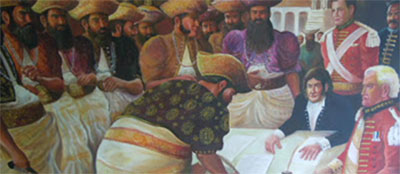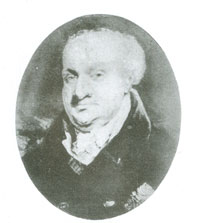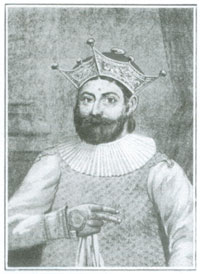75th Independence
The final conquest
View(s):- The Kandyan Convention
On February 14, 1815, General Brownrigg at the head of the second division entered Kandy, which was deserted by the king [Sri Vikrama Rajasinha] and nearly all the inhabitants. On the 18th, the king was taken prisoner with two of his wives in the house of a subordinate headman, about a mile from Medamahanuwara. The capture was effected by the rebel chief Ekneligoda Disawe, one of the adherents of Ehelapola and his men.

Artist's impression of the Kandyan Convention. (Pic courtesy National Library of Sri Lanka)

General Sir Robert Brownrigg
On the night of the 13th, while General Brownrigg was at dinner with a small party of officers, intelligence of the capture of the king reached him. “He stood at table,” says an eyewitness, “and while the tears rolled down his cheeks, shook hands with everyone present and thanked them for their assistance in furtherance of an object, which seemed to be nearly accomplished and had been vainly attempted for nearly three centuries by three European powers in succession – the conquest of the kingdom of Kandy.”

Sri Vikrama Rajasinha
“The king was formally dethroned by a convention held at Kandy between the Government and the Kandyan chiefs. On this occasion, the Governor was seated at the upper end of the Great Hall of Audience. The troops were drawn up in the square before the palace, where they remained while the Adigars and principal chiefs passed. Ehelapola, late Adigar, entered first and alone. He was received by General Brownrigg with great favour, and seated in a chair at his right hand. Molligoda acting as First Adigar, next came forward, leading in the Disawas of districts and other principal chiefs.
By the treaty which was read in English by the Deputy Secretary, and afterwards in Sinhalese by the Mudliyar, their laws, customs and institutions were guaranteed to the Kandyans, and the State religion, Buddhism, and its professors were declared inviolable.
After the treaty was again read by the Translator Mudliyar to the headmen and others standing outside the hall, the British flag was hoisted and a royal salute from the cannon of the city announced His Majesty, George III, Sovereign of the whole island of Ceylon, March 2, 1815.”
(Extracts from Twentieth Century Impressions of Ceylon)

